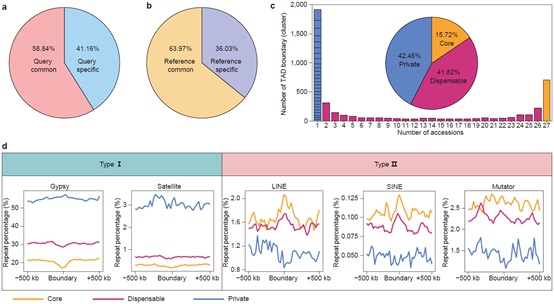High-order chromatin structure is a prerequisite for the function of cis-regulatory elements (CREs) in the genome, which plays an important role in gene regulation. In eukaryotes, the organization of three-dimensional (3D) genome presents a hierarchical pattern, where chromatin can be divided into different structural domains, such as chromosome territory (CT), A/B compartment, topologically associated domain (TAD) and chromatin loop. In former researches of mammals, there have been many studies about the dynamic changes of 3D genome during embryonic development. It has also been found that abnormal regulation of 3D genome can lead to genetic diseases and cancers. However, in plants, especially in higher plants, in-depth research on genetic diversity of 3D genome has not been carried out. The relationship between genomic variation and 3D genomic variation, the effect of 3D genomic variation on crop domestication are still poorly understood.
Recently, the research group of Prof. TIAN Zhixi from the Institute of Genetics and Developmental Biology, Chinese Academy of Sciences have investigated the genetic diversity and constructed a pan-3D genome of soybean, revealing the internal relationships among soybean genome, 3D genome and gene expression. This work, which is entitled "Pan-3D genome analysis reveals structural and functional differentiation of soybean genomes", was published in the journal Genome Biology (DOI:10.1186/s13059-023-02854-8).
The research team obtained high-quality 3D genome data by performing high-throughput chromatin conformation capture (Hi-C) experiments of 27 soybean germplasm materials that were de novo assembled in previous study. In order to investigate the conservation and variability of 3D genome, the research team performed pan-omics analysis and constructed the pan-3D genome of soybean. Pan-3D genome showed that A/B compartments were general conservative among soybean accessions, and the variation of A/B compartments was closely related to genomic features. Further analysis showed that regions with intermediate genomic features were the main region of A/B compartment switching.
TAD boundaries define the scope of interactions of TADs. In many cases, the variation of TAD boundaries represents the change of gene regulation. The research team also constructed a pan-3D genome of TAD boundaries. Pan-3D genome revealed that TAD boundaries showed a higher level of variation than A/B compartments. Further research revealed that non-LTR retrotransposons (LINE and SINE) were enriched around TAD boundaries, indicating that these two types of elements had important functions in the maintenance of TAD boundary; Besides, Gypsy elements and satellite repeats were enriched around accession-specific TAD boundaries, indicating that these elements play unique roles in the formation of specific TAD boundaries. These results explain how the transposable element (TE) superfamilies reshape the 3D genome in plants for the first time.
Genomic structural variations (SVs) are the main source of genetic variation. Due to the lack of high-quality SV data, the relationship between 3D genomic variation and genomic SV has not been investigated in plants. The research team further explored the relationship between genomic SV and 3D genomic variation based on high-quality SV data from de novo genome assembly. Research showed that Presence and Absence Variation (PAV) played the most important role in 3D genomic variation. Further analysis showed that the content of Gypsy elements and satellite repeats was significantly increased in the SVs that formed the accession-specific TAD boundaries. These results confirmed that TEs can reshape the evolution of 3D genome by driving SVs. In order to explore the relationship between 3D genome diversity and gene expression, the research team verified the correlation between 3D genome and gene expression from several levels. In addition, the research team also explored the selection process of 3D genome in wild soybeans, landraces and cultivars during domestication and improvement. It showed that the selection of 3D genome mainly occurred in the domestication period rather than the improvement period. These selections reshaped the gene regulation and led to the change of gene expression of soybean.
“This work investigated the genetic diversity of 3D genome among plant germplasms through the pan-3D genome construction, revealed the roles of plant TEs in reshaping 3D genome, analyzed the 3D genome variation caused by genomic SVs, and the selection and subsequent functional effects of 3D genome during crop domestication. These studies provide a new way to understand the evolution of plant genome, and also provide valuable resources for molecular design breeding”, said TIAN Zhixi, the group leader and corresponding author of the study.
Pan-3D genome of TAD boundaries and TE distribution patterns. (Image by NI et al.)
Contact:
Prof. TIAN Zhixi
Institute of Genetics and Developmental Biology, Chinese Academy of Sciences
 Pan-3D genome of TAD boundaries and TE distribution patterns. (Image by NI et al.)Contact:Prof. TIAN ZhixiInstitute of Genetics and Developmental Biology, Chinese Academy of SciencesEmail: zxtian@genetics.ac.cn
Pan-3D genome of TAD boundaries and TE distribution patterns. (Image by NI et al.)Contact:Prof. TIAN ZhixiInstitute of Genetics and Developmental Biology, Chinese Academy of SciencesEmail: zxtian@genetics.ac.cn CAS
CAS
 中文
中文




.png)
